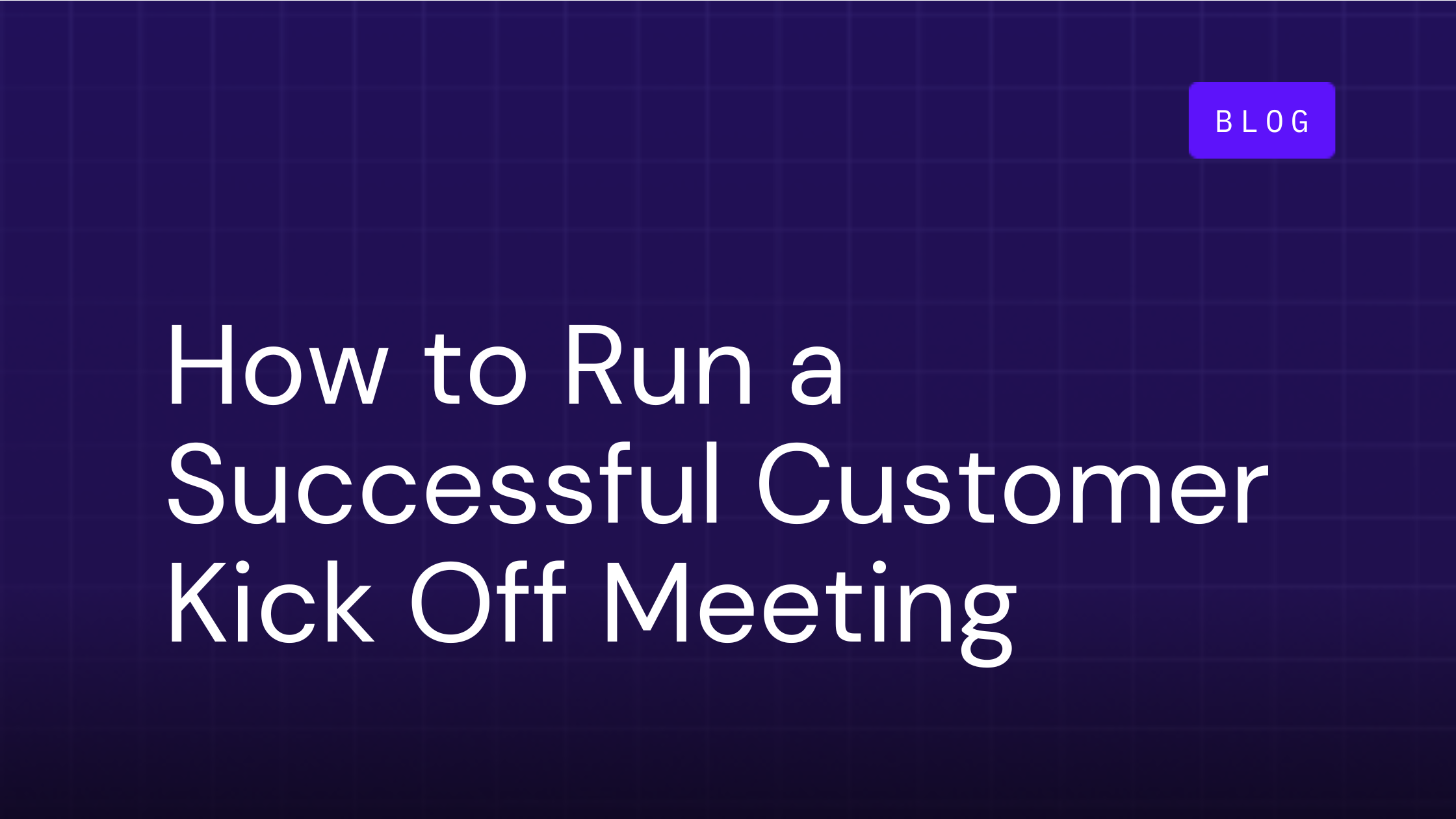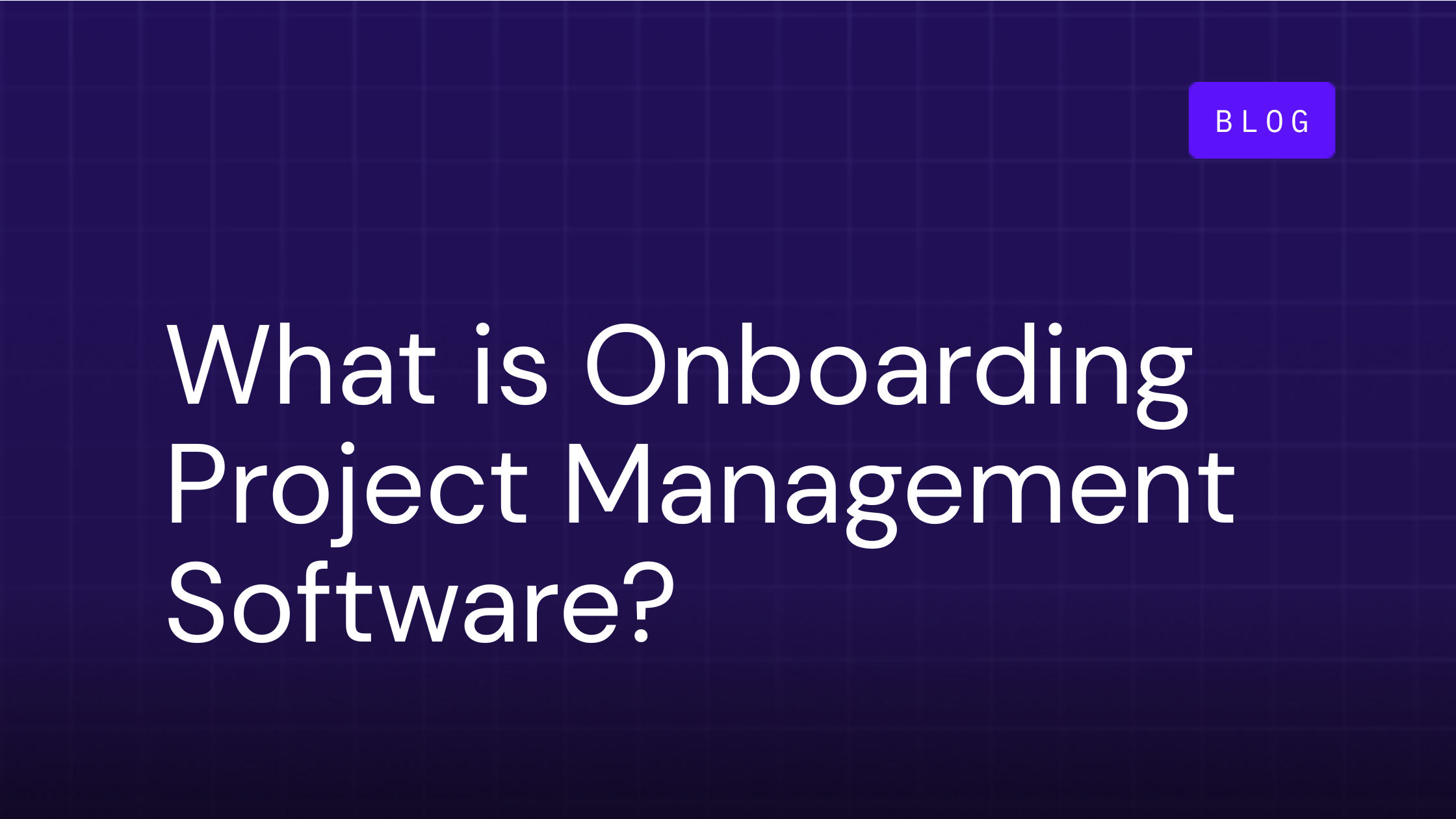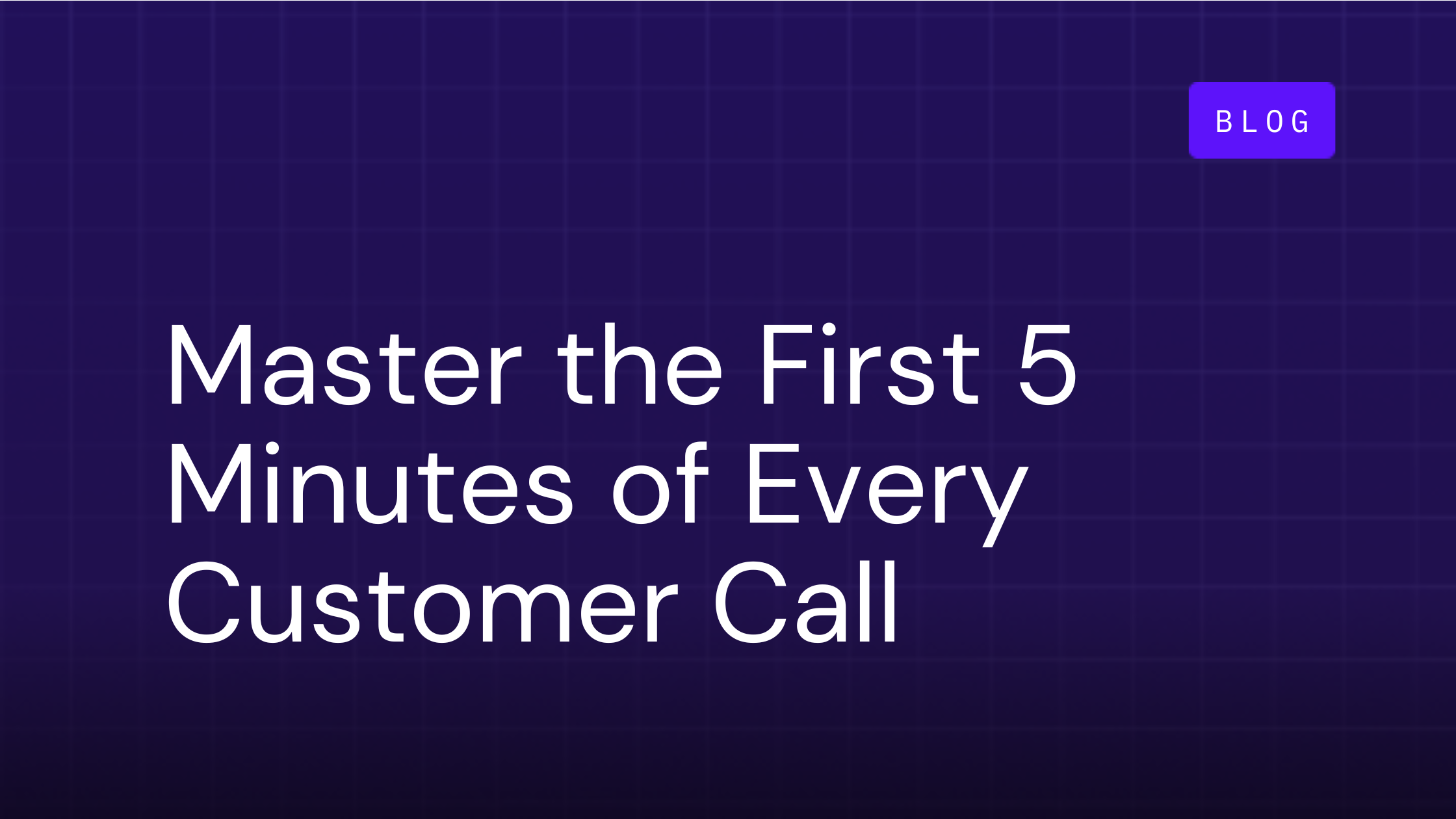How to Run a Successful Customer Kick Off Meeting
Published: September 10, 2024

Table of Contents
In the past few years, the cost of winning new customers has skyrocketed—nearly doubling since 2013. That’s why starting off every client relationship the right way is so critical for your business. After putting in all that effort to bring a customer on board, the last thing you want is to lose them because of a disjointed onboarding process!
However, you don't necessarily want to jump write into your product and begin technical onboarding journey on day one. That can feel impersonal and overwhelming. Instead, begin by establishing the foundations of a strong working relationship.
This is what kick-off meetings are for. Customer kick off meetings help companies and their customer get on the same page from day one. That can lead to a better onboarding experience and a longer relationship with the customer.
What’s a Kick-Off Call in Customer Success?
A kick-off call is the first meeting that a customer success team has with a new client. Its purpose is to help launch a successful business relationship with that customer. To that end, a typical kick-off meeting agenda will cover:
- Welcomes and introductions
- Timelines and goals
- Processes and practices
- Expectations from both sides
- Brief introductions to relevant tools and technologies
You should also leave the client time to bring up their concerns and questions. This meeting is, ultimately, designed to help them feel more comfortable with your business. That probably won’t happen if you do all the talking.
Why Kick-Off Meetings Matter
More than 90% of customers say companies could do better at onboarding, and many will leave a provider when its onboarding process is poor. That’s why kick-off calls matter. They start a customer’s onboarding journey positively, which is an essential first step in retaining their business long-term.
How To Prepare for a Client Kick-Off Meeting
Now that you know what kick-off meetings are and why they matter, let’s focus on preparing for one. This eight-step process will get you started.
1. Create an Agenda
The first action item is setting an agenda. This is a loose schedule for the kick-off meeting, which you typically share with attendees ahead of time. Doing so puts everyone on the same page before the meeting.
Though the exact schedule will depend on the nature of the project, your project kick-off meeting agenda might include:
- 10 minutes each for introductions, project scope review, and timeline
- 15 minutes for client questions and concerns
- 15 minutes to discuss project purpose and goals
Additionally, you can include links to key documents and contact information. These things often come up in an intro call, and putting them on the kick-off meeting agenda template will make them easier for everyone to find.
2. Make Sure You Have All Necessary Client Documents
By the time you schedule your kick-off meeting, you should have a clear understanding of your client’s goals and needs. This means having concrete answers to the following:
- Agreed upon deliverables
- Metrics for measuring success
- Expected timelines
- Payments
- Other logistical concerns
If you aren’t sure about these things, reach out to the customer for more information. You don’t want to risk scheduling a kick-off call and looking unprepared when the client begins discussing some of their concerns.
3. Invite the Right Group
The next question to consider is who should attend your project kick-off meeting. The answer is any relevant stakeholders. On your end, that includes anyone on the team who may engage with the client. The customer will help you decide who to invite from their side.
Just remember, if you invite too many people, the meeting may run long or become more chaotic. To keep the guest list smaller, consider recording the session so others can watch it afterward.
4. Establish Key Roles
Next, think about the roles you need to fill for this project. For example, who will be the main point of contact for the client? And whose job will it be to keep the project on time and budget?
These are questions you want to be able to answer clearly during a first meeting with a new customer. However, the specific roles you must assign can vary based on the work and who’s involved in it. For example, you might need to assign people to roles like:
- Project leader
- Marketing and sales
- Customer success and onboarding
- Ownership of specific action items from the customers’ request
5. Set Measurable Goals
Another part of customer kick-off meetings is agreeing on goals. Both parties should leave the conversation on the same page about what’s being worked on and how you’ll measure success.
For example, you might talk about improving the client’s operational efficiency by 15% over the next three months. This sets a clear benchmark for success while creating a natural opportunity to reconvene with the customer next quarter.
Embracing this kind of accountability should help you build stronger relationships. It shows the client how invested you are in their long-term success — not only interested in maximizing profits.
6. Address Downsides and Risks
As you near the end of your project kick-off meeting checklist, don’t forget to schedule time to discuss downsides and risks. Every business endeavor has them, and it’s worth putting them out in the open at an early stage.
Doing so makes everyone aware of what could go wrong during the project. This can be all it takes to reduce some risks. Also, discussing downsides can improve your relationship with a new customer. It may signal your good intentions by showing clients you’re not trying to hide anything from them.
7. Leave Time for Questions
It’s smart to leave time for a client-led Q&A session at the end of a kick-off call. But give them opportunities throughout the meeting, too. Otherwise, they may not have time to ask all their questions and may not receive all the information they need.
The easiest way to do this is to ask the client if they have any questions at the end of each section of your agenda. For example, when you finish discussing timelines, you can ask the customer if they have any comments or concerns before moving on.
8. Outline the Next Steps and Follow Up
Lastly, conclude your meeting by answering the question, “What comes next?” Clarify how you’ll share project updates and when you’ll meet again and address any other lingering questions.
Then, reach out to the client about a week after the kick-off meeting to see how they’re doing. This kind of follow-up can help you stand out from a customer service perspective.
Risks of Skipping the Kick-Off Call
Despite their advantages, some businesses continue to skip kick-off calls with new clients — often out of a misplaced emphasis on efficiency. In reality, the hour or so that a kick-off meeting takes can save much more than that through the lifespan of the client relationship.
But that’s just one reason not to skip your next kick-off meeting. Here are several other risks you’d assume by doing so.
Unmatched Expectations
Your sales process probably revealed some details about your new client’s expectations for the partnership. But it’s not wise to assume you understand those expectations perfectly. Doing so is a recipe for misalignment and frustration.
For example, the customer may want to prioritize one of their goals before pursuing others with you. They might also have unique timeline considerations you aren’t aware of. Or, they could have simply changed their mind from what you talked about while earning their business.
Hosting a kick-off meeting helps you avoid all these assumptions and miscommunications. It ensures you’re starting from a common understanding with every customer.
Scope Creep
Kick-off calls are an opportunity to discuss what you can achieve for a client within a specified period. If you don’t have one, the client may expect more from your team than it can realistically deliver. This kind of project scope creep can lead to dissatisfaction early in your relationship with a new customer.
For example, you don’t want a client to assume that you can complete all of their tasks within the next few weeks if that’s unrealistic. But, you may not get an opportunity to hear and address that expectation if you skip a kick-off meeting.
Wasted Resources
There’s also a risk of wasting labor hours and project resources when skipping kick-off meetings. This stems from not being aligned with the client’s goals and expectations.
For instance, you might waste a few days working on one aspect of the project while the client assumed you would start with another. This can cause frustration and an inefficient use of resources.
Other Tips for a Successful Kick-Off Meeting
Let’s wind down by discussing a few additional tips for your next kick-off meeting for a project.
Complete an Internal Kick-Off Call
One of the best ways to ensure kick-off-call success is to host one internally before meeting with the client. This is an opportunity to get everyone on the client success team on the same page before engaging with the customer.
You may also want to use the opportunity to assign roles. For instance, you could talk about who will take notes during the meeting and who will lead different parts of your remarks.
Ask The Right Questions
Kick-off meetings are an opportunity to gather information. You’ll get much more out of these sessions if you consider the questions you want to ask beforehand. So, here are some examples to get you started:
- Can you tell me your high-level objectives or goals for this collaboration?
- Who are the key stakeholders on your side we should keep in the loop?
- Do you have any project requirements or standards we haven’t discussed yet?
- How do you prefer we communicate with you?
- How often would you like us to check in?
You can use answers to these questions to refine your customer service approach with a client. But, the best questions to ask could vary based on your goals and the nature of the working relationship. Consider, therefore, making a project kick-off meeting template with the questions specific to your situation.
Focus on Building Rapport
Finally, make sure to add a personal touch to your kick-off session. You and your client may hope to accomplish a lot during this introductory call. But that shouldn’t be at the expense of getting comfortable with one another.
Ideally, you’ll leave your kick-off meeting feeling like you have a personal connection to the client or someone on their team. If you feel like you don’t know people on the other side any better after the call, that’s usually a bad sign.
These tips for building professional rapport will get you started if you need extra guidance.
Get More Value From Your Onboarding Process With OnRamp
Ultimately, a customer kick-off meeting helps you understand what new clients expect from your onboarding process. But you’ll still need to take those insights and use them.
That’s where OnRamp comes into play. Our onboarding software is highly detailed and easy to customize. Once a customer tells you what they want, you can create a unique experience for them that establishes a strong relationship and complete onboarding tasks. You can even personalize the onboarding journey on a user-by-user basis. It can all help you get more value out of this critical early stage of a new partnership.
But don’t take our word for it. Schedule a free demo today to learn more about how OnRamp can help your business thrive.
Customer Success Kick-Off Meetings FAQs
How long should a kick-off call be?
Kick-off meetings generally last for an hour or less. They’re designed for high-level conversation and introductions — not getting into the details of an upcoming project. However, you may need a longer meeting for an especially complicated (or large) client.
Does every client need a kick-off meeting?
Yes, you should generally schedule a kick-off meeting with every new client you get. Doing so is an important part of creating a strong relationship, which can influence customer loyalty.
How do you follow up a kick-off call?
The best way to follow up a kick-off call will probably reveal itself in the meeting. For example, you’ll likely agree on some next steps and can simply proceed according to them. But maybe you won’t leave some meetings with clear points for follow-up. In that case, you can email the client to see how they’re doing within a week or so after the initial meeting.
FAQ Title
Lorem ipsum dolor sit amet, consectetur adipiscing elit. Integer eget hendrerit metus. Curabitur a diam ultricies, vulputate quam non, aliquet sem. Nulla nisi enim, mollis ut tempus et, pulvinar eu urna. Mauris commodo turpis elit, sed dictum orci pharetra ac. Vivamus pellentesque risus eu augue gravida vestibulum. Nullam aliquet, magna faucibus tristique cursus, lacus augue venenatis elit, non gravida mi orci in velit. Quisque non hendrerit ex, in faucibus diam.
FAQ Title
Lorem ipsum dolor sit amet, consectetur adipiscing elit. Integer eget hendrerit metus. Curabitur a diam ultricies, vulputate quam non, aliquet sem. Nulla nisi enim, mollis ut tempus et, pulvinar eu urna. Mauris commodo turpis elit, sed dictum orci pharetra ac. Vivamus pellentesque risus eu augue gravida vestibulum. Nullam aliquet, magna faucibus tristique cursus, lacus augue venenatis elit, non gravida mi orci in velit. Quisque non hendrerit ex, in faucibus diam.
FAQ Title
Lorem ipsum dolor sit amet, consectetur adipiscing elit. Integer eget hendrerit metus. Curabitur a diam ultricies, vulputate quam non, aliquet sem. Nulla nisi enim, mollis ut tempus et, pulvinar eu urna. Mauris commodo turpis elit, sed dictum orci pharetra ac. Vivamus pellentesque risus eu augue gravida vestibulum. Nullam aliquet, magna faucibus tristique cursus, lacus augue venenatis elit, non gravida mi orci in velit. Quisque non hendrerit ex, in faucibus diam.
Related Posts:

What is Customer Onboarding Project Management Software?
You already know that customer onboarding is one of the most crucial stages of project management! It helps customers familiarize...

How to Use the First 5 Minutes of Every Customer Call Effectively
The first five minutes of that kickoff call are the most important five minutes of this new team-customer relationship. You gotta...

Onboarding New Customers: Why Time-to-Value Has to Start from Day One
Onboarding is a critical time, but time always runs out Customer Onboarding. The part of the customer lifecycle that starts with a...